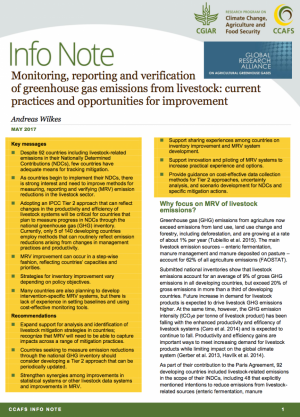
As countries begin to implement the Paris Agreement, many need to improve systems to track mitigation in the livestock sector.
In their Intended Nationally Determined Contributions to the Paris Agreement, 92 developing countries mentioned livestock-related emissions, and 48 of the 92 explicitly mentioned intentions to reduce emissions from livestock-related sources such as enteric fermentation, manure management and biogas, and grasslands and silvopastoral syste ms. But how do countries plan to document reduced emissions?
ms. But how do countries plan to document reduced emissions?
The Paris Agreement requires countries to submit national greenhouse gas (GHG) inventory reports, information on implementation and achievement of NDCs, account for their NDCs, and climate finance requires reliable estimates. Countries have monitoring, reporting and verification (MRV) systems to meet these requirements, but many MRV systems lack completeness, consistency, accuracy or transparency. While no global, one-size-fits-all livestock MRV system is possible, and countries and projects have flexibility in how they shape their MRV systems, all MRV systems must be scientifically robust, feasible, and relevant to their context and policy goals.
As of February 2017, only 5 developing countries have MRV methods in place that can measure emission reductions in livestock resulting from changes in agricultural management practices or increases in productivity, found researcher Andreas Wilkes of UNIQUE Forestry and Land Use in Monitoring, reporting and verification of greenhouse gas emissions from livestock: current practices and opportunities for improvement, an info note published by CCAFS this month.
Given the pressing need for improved livestock MRV systems, CCAFS, UNIQUE Forestry and Land Use, the Global Research Alliance on Agricultural Greenhouse Gases (GRA) and the Food and Agriculture Organization of the United Nations (FAO) – with support from the New Zealand government, the United States Agency for International Development (USAID) and the World Bank – are studying opportunities for improved MRV systems to enable developing countries to meet their mitigation goals. Key findings and recommendations are available in this info note; and a full report in English, French, and Spanish is expected later in 2017.








